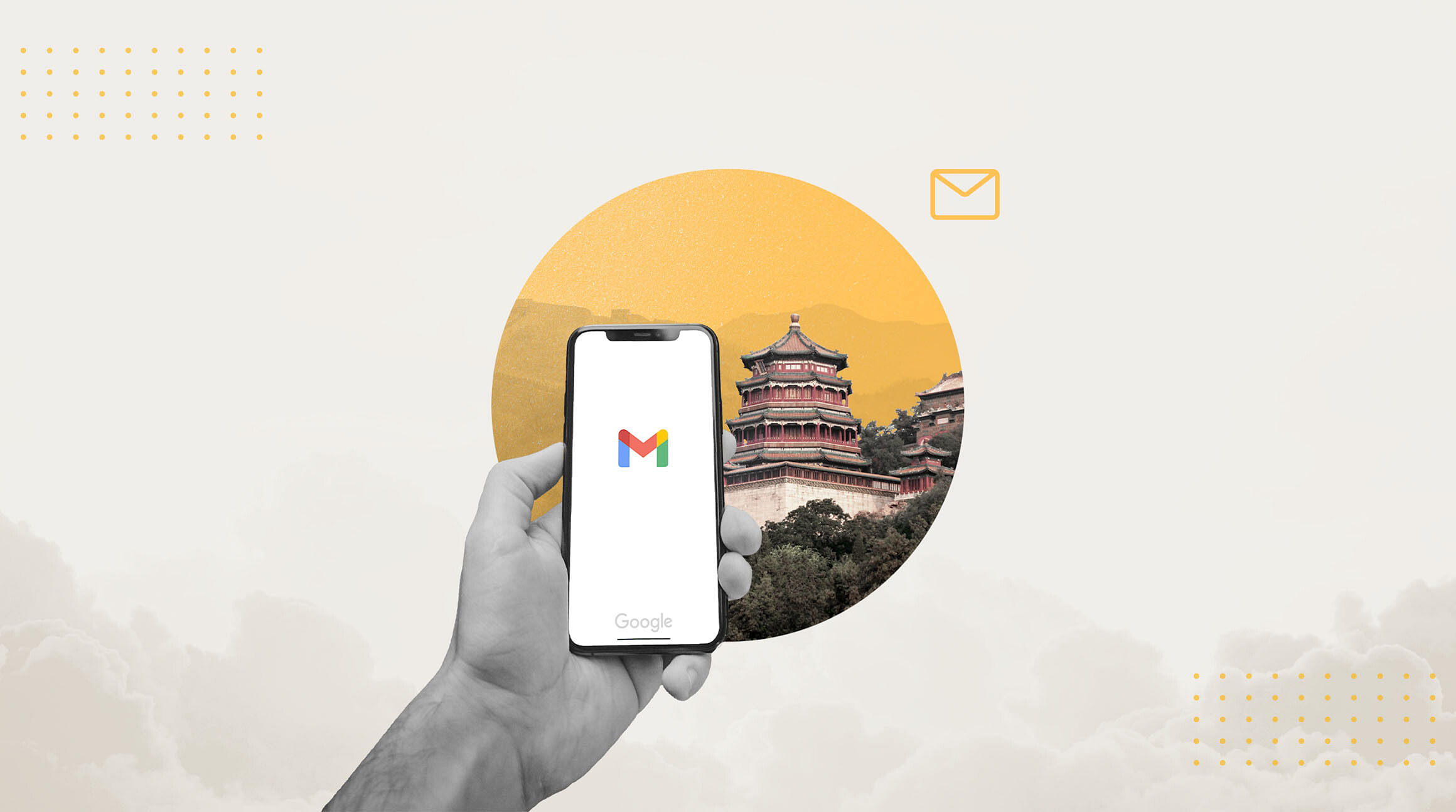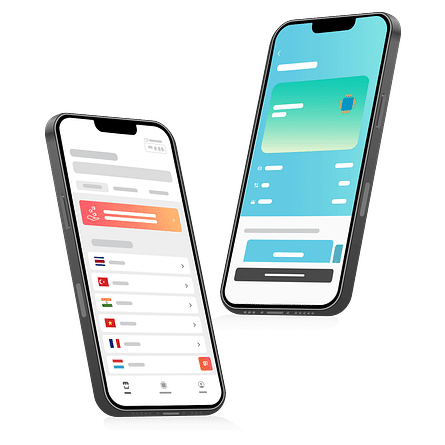
Trying to get into your Gmail inbox in China? Yeah, it’s definitely not as simple as tapping the app and waiting for your inbox to load.
The canals of Suzhou (宿州) are gorgeous. My Google connection? Not so much.
I found that out the hard way when I was working remotely in a café by a canal in Suzhou (宿州).
I stared at loading screens and error messages while my emails disappeared into the void, wondering if clients thought I’d ghosted them.
Between the Great Firewall, endless website blocks, and Wi-Fi that feels like it’s running on dial-up, getting online in China takes more than just a VPN.
Whether you’re a digital nomad like me or just trying to fire off a time-sensitive email while exploring the canals of Suzhou, Gmail won’t play nice unless you’re prepared.
In this guide, I’ll walk you through exactly how I accessed and set up Gmail in China, why even the best VPNs might not be enough, and how switching to an eSIM completely changed the way I stay connected while traveling in China.
Why You Can’t Use Gmail Freely in China
If you’ve tried checking Gmail in China and got hit with endless error pages or frustrating “can’t connect” messages, welcome to the world of the Great Firewall.
The Great Firewall is China’s advanced internet censorship system, designed to block access to foreign websites and services like Gmail.
This digital fortress has been beefing up since the early 2000s and is designed to keep foreign websites and services (like Google Maps and Zoom) well out of reach if they don’t play by government rules.
This isn’t your run-of-the-mill content filter. It combines techniques such as DNS spoofing, IP blocking, and deep packet inspection to restrict digital communication.
The streets of Xi’an were a lot larger than I thought
I didn’t realize how intense this was until I stepped out of my hotel and onto Zhuque Street North (区朱雀北街) in Xi’an (西安). Talk about a wake-up call!
This digital control isn’t random or accidental. The Chinese government has spent decades crafting a closely monitored online environment, maintaining tight control over the flow of information in and out.
Blogs, social media, and search engines, all under watchful eyes. Services that don’t fit their mold, like Gmail, simply get shut out.
Why Hotel Wi-Fi and Local VPNs May Not Be Enough
Common Connectivity Issues with Hotel Wi-Fi
If you think hotel Wi-Fi is your safety net in China, think again. I’ve crashed in everything from fancy hotels to cozy guesthouses across the country, and let me tell you, the internet was often either painfully slow or downright useless for accessing blocked services.
Forget streaming your favorite shows or syncing your inbox smoothly; sometimes, even the VPN refused to cooperate. To make matters worse, hotel Wi-Fi often comes with locked-down ports that kill VPN connections faster than you can say “buffering.”
Some VPNs have been known to drop every five minutes. An absolute nightmare if you’re trying to work or stay in touch. If your travel or work depends on steady internet, counting on hotel Wi-Fi alone is like building a house on sand.
VPNs Are Useless Without a Working Data Connection
VPNs cannot function without a stable internet connection.
In China, unreliable Wi-Fi and mobile data can prevent VPNs from establishing secure tunnels, making access to Gmail impossible.
I’ve had my VPN installed and subscription ready to roll, only to find the local SIM or Wi-Fi just won’t let it connect. No VPN tunnel means no Gmail, no Slack, no Google Docs. You’re stuck in digital limbo.
The kicker? Gmail often sends time-sensitive security codes or login approvals that won’t arrive if you get blocked mid-login. I once had a client waiting for me to approve access to a document, and I just couldn’t, all because my VPN wouldn’t connect.
If you rely on email for work or communication, this isn’t a “nice to have” situation. It’s mission-critical to have reliable data the moment you step off the plane.
The Smarter Solution: Use an eSIM for Reliable Internet
If you’ve ever landed in China only to realize you can’t load Gmail, Google Maps, or half the internet, you know the panic.
I learned the hard way in Xi’an, standing on a street corner with a useless phone and no way to navigate. That’s when I switched to using an eSIM, and I haven’t looked back since.
An eSIM is a digital SIM built into your device, letting you activate mobile data plans remotely.
You can even do this before you leave the airport back home. No kiosks, no SIM-swapping, no language barrier drama.
I now preload Airalo’s China eSIM, and the moment I land, I'm online. That means I can launch my VPN, check Gmail, and get going without missing a beat.
Here’s why using an eSIM like Airalo’s is a smart move for China:
- Affordable even for the budget traveller - Just $3.50 per day for unlimited data
- Preload data before arrival – avoid the scramble for local SIMs
- Instant internet access – your phone connects the moment you land
- Works seamlessly with VPNs – perfect for Gmail, Google, and other blocked services
- No physical SIM required – no fumbling with cards or tools
- Stable coverage across provinces – no signal drops as you move around
In a country where internet access can be tricky, having a reliable connection isn’t a nice-to-have anymore. It’s essential.
How to Set Up Gmail in China: A Step-by-Step Guide
Step 1: Install a Reliable VPN Before You Arrive
Trying to download a VPN after you land in China? That’s like arriving at a pool party without a swimsuit. It’s way too late.
On my first solo trip, I learned this the hard way: Google, Gmail, WhatsApp, and even VPN sites were all blocked. To dodge that headache, get your VPN downloaded and installed before you leave home.
The best VPNs for China in 2025 are masters of disguise, using “stealth mode” or “obfuscated servers” that make your VPN traffic look like regular internet activity.
This is a must-have in a country where the Great Firewall’s deep packet inspection hunts for VPNs like a hawk.
Test your VPN thoroughly back home to make sure it’s fast and stable.
Step 2: Connect to the VPN via eSIM Data
As soon as your flight lands, flick off airplane mode and let your eSIM do its magic. Then, fire up your VPN connection before opening Gmail or anything Google-related.
Airalo’s China eSIMs can be easily installed via these simple steps
Why? Because if your phone tries to access blocked sites without encryption first, it risks being flagged, and this can disrupt your VPN connection.
Before your trip, it’s worth running a VPN test or checking out your provider’s recommended servers. WireGuard and LetsVPN tend to work best behind China’s firewall.
Don’t rely on sketchy hotel Wi-Fi to set this up; your eSIM connection is both more secure and often the only one that works smoothly.
Step 3: Log in or Create a Gmail Account Securely
Got a Gmail account? Sweet. Logging in through your VPN should be a breeze.
Creating one with a Chinese number? Trickier. Google’s phone verification often struggles with Chinese numbers, or the SMS just never arrives.
I got around this by setting up a backup phone number from another country and configuring recovery options like a secondary email and two-factor authentication before I left home.
Gmail’s security can freak out about logins from new locations, so log in once at home with your VPN to smooth things out.
Trust me, nothing’s more annoying than being locked out and unable to reset your password once you’re in China. Prep now to avoid panic later.
Step 4: Use Secure Email Apps or Web Versions
Whether you love the Gmail app or prefer the browser, your strategy matters. The app usually runs smoother once your VPN’s up and running, especially if it’s already synced before your trip.
Browsers like Chrome also work well through a VPN tunnel. Just be sure to keep HTTPS enabled everywhere, because security isn’t a joke, especially on restricted networks.
Avoid incognito mode; Gmail hates it and often demands extra verification steps that will drive you nuts. Set up trusted devices ahead of time, and you’ll enjoy a much smoother email experience behind the firewall.
Bonus Tips for Managing Email Access in China
Tip 1: Enable Offline Gmail Access Before You Go
Landing in China and seeing your Gmail refuse to load? Nightmare. Enabling offline mode before you leave is like packing a digital parachute. You can read, draft, and search emails without the internet.
Not perfect, but a serious lifesaver while waiting for your VPN or eSIM to kick in. Just hop into Gmail settings on a reliable connection at home, turn on offline mail, and pick how many days of email to sync.
Your browser caches those emails, so you’re not totally offline when the Great Firewall throws up its walls.
Tip 2: Back Up Important Emails
Your inbox is often a treasure trove of work stuff, project details, and passwords, and you don’t want those locked behind China’s firewall.
Backups don’t have to be complicated. I forward critical threads to a secondary email account that’s easier to access (Outlook often plays nicer) and regularly export my data using Google Takeout. It’s a simple habit that keeps me from sweating when the internet goes wonky.
When you juggle clients across time zones like I do, waiting for Gmail to load isn’t an option. Backup means you’re prepared, not hoping.
Tip 3: Use Two-Factor Authentication (Without SMS)
Getting locked out of Gmail because your 2FA depends on SMS is an all-too-common pain. Skip that drama. Use an authenticator app, such as Google Authenticator or Authy. They generate offline codes and don’t need a cell signal.
Set this up before you leave, and you add a vital security layer that actually works in China. If your work depends on Gmail (and let’s face it, most of us), this quick fix is non-negotiable.
Stay Connected Without Limits: Your Gmail Solution in China
From understanding why Gmail gets the cold shoulder to setting up VPNs and leveraging offline features, these tips have kept me connected wherever I roam.
The headline? Without a rock-solid internet connection, even the best VPN won’t get you through the Great Firewall.
That’s where eSIMs come in. For anyone traveling or working in China, Airalo’s China eSIMs have been a total game changer, making VPN connections smooth and Gmail flowing without a hitch.
Frequently Asked Questions about Using Email in China
Does Outlook work in China?
Yes, Outlook generally works in China, especially if you're accessing it through Microsoft Exchange or the Outlook app. However, syncing issues may occur without a VPN.
Can foreigners use Google in China?
Not without a VPN. Google and all its services (Gmail, Maps, Docs, etc.) are blocked in China and require a reliable VPN to access.
Which email can be used in China?
Chinese providers and Gmail alternatives like QQ Mail, 163.com, and 126.com work without issues. Foreign email like Outlook may work, but Gmail requires a VPN.



